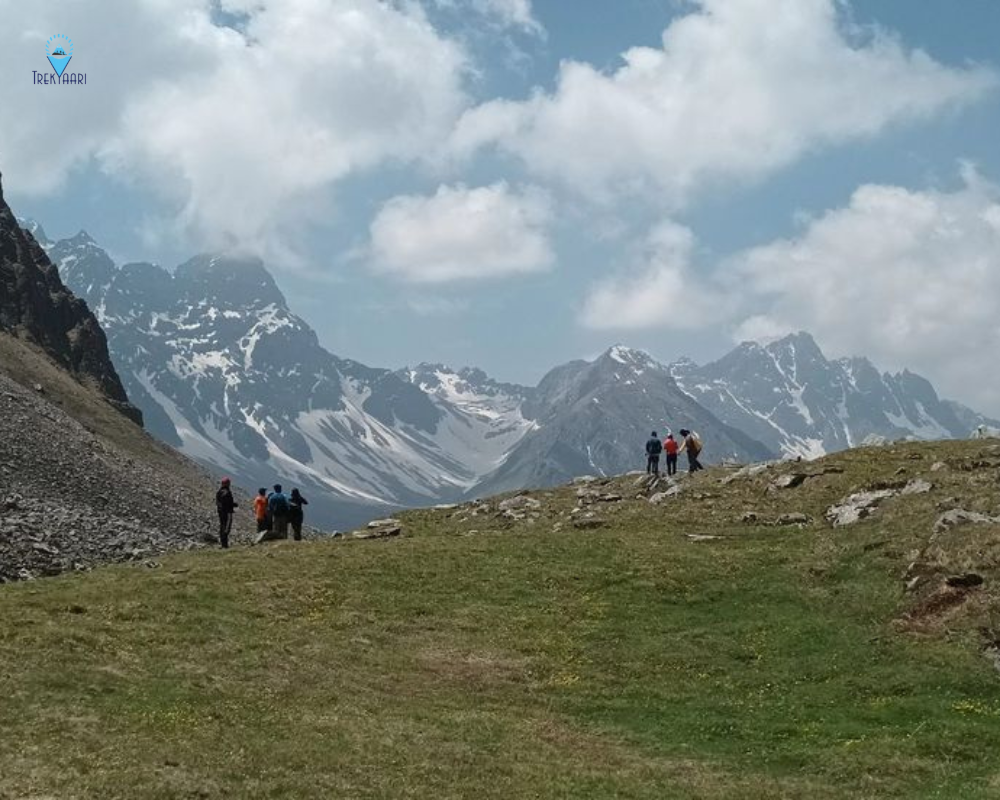The Buran Ghati Trek is a thrilling and picturesque adventure nestled in the heart of the Himalayas, offering a perfect blend of lush meadows, dense forests, sparkling streams, and challenging passes. Whether you're a seasoned trekker or a beginner looking for your next big adventure, this trek promises an unforgettable experience. However, like any high-altitude trek, proper preparation is crucial to ensure a safe and enjoyable journey. This guide will walk you through everything you need to know to prepare for the Buran Ghati Trek.
Understanding the Buran Ghati Trek
Before diving into the logistics, it's important to understand what the Buran Ghati Trek entails. Located in the Kinnaur district of Himachal Pradesh, this trek stretches over approximately 37 kilometers and takes you through a diverse landscape. The highlight of the trek is crossing the Buran Pass at an altitude of 15,000 feet, offering panoramic views of the surrounding peaks.
Trek Duration and Difficulty
The Buran Ghati Trek itinerary typically spans 7 to 8 days, depending on your pace and acclimatization needs. The trek is considered moderately difficult, making it suitable for those with some prior trekking experience. The trail includes steep ascents, tricky descents, and sections that require basic mountaineering skills, especially while crossing the Buran Pass.
Best Time to Trek
The best time to undertake the Buran Ghati Trek is during the summer months of May to June and the post-monsoon period from September to October. During these times, the weather is relatively stable, and the trails are clear of snow, offering safe and scenic trekking conditions.
Physical Preparation for the Buran Ghati Trek
Trekking at high altitudes requires a good level of physical fitness. To tackle the Buran Ghati Trek successfully, you need to start your physical preparation at least two months in advance.
Cardiovascular Training
Cardiovascular endurance is crucial for trekking in the mountains. Incorporate activities like running, cycling, swimming, or brisk walking into your daily routine. Aim for at least 30-45 minutes of cardio exercises, five days a week. This will help improve your stamina and ensure you can handle the long hours of trekking.
Strength Training
Strong legs are essential for trekking, especially for handling steep ascents and descents. Focus on exercises that target your legs, such as squats, lunges, and step-ups. Additionally, include core-strengthening exercises like planks and crunches, as a strong core helps in maintaining balance on uneven terrains.
Flexibility and Balance
Flexibility plays a significant role in preventing injuries during the trek. Incorporate stretching exercises and yoga into your routine to improve flexibility. Balance training, such as standing on one leg or using a balance board, can also be beneficial, especially for navigating rocky and slippery paths.
Acclimatization and High Altitude Considerations
Acclimatization is crucial when trekking at high altitudes to prevent altitude sickness. The Buran Ghati Trek itinerary is designed to include gradual ascents, allowing your body time to adjust to the thinning air.
Understanding Altitude Sickness
Altitude sickness occurs when your body struggles to adjust to lower oxygen levels at high altitudes. Symptoms include headaches, nausea, dizziness, and shortness of breath. If not addressed, it can escalate to more severe conditions like High Altitude Pulmonary Edema (HAPE) or High Altitude Cerebral Edema (HACE), both of which are life-threatening.
Tips for Proper Acclimatization
To reduce the risk of altitude sickness, follow these tips:
- Ascend Gradually: Avoid rapid ascents. Spend an extra day at mid-altitude camps to allow your body to acclimatize.
- Stay Hydrated: Drink plenty of water to help your body adapt to the altitude.
- Avoid Alcohol and Smoking: These can exacerbate the effects of altitude sickness.
- Listen to Your Body: If you experience symptoms of altitude sickness, inform your trek leader immediately. Rest and, if necessary, descend to a lower altitude.
Essential Gear and Packing List
Having the right gear can make or break your trekking experience. The Buran Ghati Trek requires specific equipment to ensure you are comfortable and safe throughout the journey.
Clothing
Layering is key when trekking in the Himalayas. Here's what you should pack:
- Base Layer: Moisture-wicking thermal tops and bottoms.
- Insulating Layer: Fleece jackets or down jackets for warmth.
- Outer Layer: A waterproof and windproof jacket and pants to protect against the elements.
- Trekking Pants: Comfortable and quick-drying.
- Trekking Boots: Sturdy, waterproof, and broken in before the trek.
- Socks: Wool or synthetic socks to keep your feet warm and dry.
- Gloves, Hat, and Scarf: Essential for cold mornings and evenings.
Trekking Gear
- Backpack: A 40-50 liter backpack with a rain cover.
- Daypack: A smaller pack for carrying essentials during daily treks.
- Trekking Poles: Helpful for balance and reducing strain on your knees.
- Headlamp: With extra batteries for use in campsites and early morning starts.
- Sleeping Bag: Rated for temperatures as low as -10°C, suitable for Himalayan nights.
- Water Bottle and Purification Tablets: To stay hydrated with safe drinking water.
Personal Items
- First Aid Kit: Including basic medications, band-aids, and blister treatment.
- Sunscreen and Lip Balm: High SPF to protect against the strong mountain sun.
- Sunglasses: UV protection is essential at high altitudes.
- Personal Hygiene Items: Wet wipes, hand sanitizer, biodegradable soap, and toiletries.
Mental Preparation for the Trek
While physical fitness is essential, mental preparation is equally important. Trekking in the Himalayas can be mentally challenging, especially when faced with harsh weather, tough terrain, and long days of walking.
Setting Realistic Expectations
Understand that the Buran Ghati Trek is demanding, and there will be moments of discomfort and fatigue. Setting realistic expectations helps you stay mentally prepared for the challenges ahead.
Staying Positive and Motivated
Maintaining a positive attitude is key to overcoming difficulties on the trail. Surround yourself with fellow trekkers who share your enthusiasm and encourage each other along the way. Remember why you chose to embark on this adventure, and let that motivate you through tough times.
Understanding the Buran Ghati Trek Itinerary
Knowing the itinerary in advance helps you mentally and physically prepare for each day's challenges and highlights. Here’s a typical Buran Ghati Trek itinerary:
Day 1: Arrival in Janglik
The trek begins in the quaint village of Janglik, where you spend the night acclimatizing and preparing for the days ahead. The journey to Janglik offers stunning views of lush green valleys and towering peaks.
Day 2: Janglik to Dayara Thach
The first day of trekking takes you through dense forests of pine and oak before opening up into the beautiful meadows of Dayara Thach. This campsite offers spectacular views of the surrounding mountains.
Day 3: Dayara Thach to Litham
This day involves a moderate trek through more meadows and along rivers, eventually reaching the campsite at Litham. The views of the snow-capped Dhauladhar range are a highlight of this section.
Day 4: Acclimatization and Exploration at Litham
To aid in acclimatization, spend a day at Litham exploring the nearby Chandranahan Lake, a sacred spot revered by locals. This day helps your body adjust to the altitude and prepares you for the tougher days ahead.
Day 5: Litham to Nalabansh
A challenging day, involving a steep climb to Nalabansh, which is situated closer to the Buran Pass. The terrain becomes more rugged as you gain altitude, but the breathtaking views make it worthwhile.
Day 6: Nalabansh to Munirang via Buran Pass
This is the most challenging day of the trek, where you cross the Buran Pass at 15,000 feet. The ascent is steep and often snow-covered, requiring caution and perseverance. The descent to Munirang on the other side is equally demanding but rewarding with stunning views.
Day 7: Munirang to Barua Village
The final day of trekking takes you downhill to Barua Village, marking the end of your adventure. The trail passes through apple orchards and terraced fields, offering a peaceful and scenic conclusion to the trek.
Day 8: Departure from Barua Village
After a good night's rest, depart from Barua Village, carrying memories of the epic journey. Transportation back to major towns like Shimla can be arranged from here.
Safety Precautions and Tips
Trekking in the Himalayas requires careful attention to safety. Here are some tips to ensure a safe experience on the Buran Ghati Trek:
Hire a Guide
While the trail is well-marked, hiring a local guide can be invaluable, especially during tricky sections like the Buran Pass. A guide can help you navigate the terrain, manage altitude sickness, and provide insights into the local culture and environment.
Stay Informed About Weather Conditions
Weather in the mountains can change rapidly. Always check the forecast and be prepared for sudden changes. Carrying a satellite phone or a walkie-talkie can be helpful in case of emergencies.
Respect the Environment
The Himalayas are a fragile ecosystem. Practice responsible trekking by carrying back all your waste, using biodegradable products, and sticking to marked trails to minimize your impact on the environment.
Insurance and Emergency Plans
Ensure you have comprehensive travel insurance that covers high-altitude trekking and emergency evacuations. Familiarize yourself with the nearest medical facilities and emergency evacuation procedures.
Cultural Insights and Etiquette
The Buran Ghati region is rich in culture, and interacting with locals can be a rewarding part of your trek. Here are a few things to keep in mind:
Respect Local Customs
Himachal Pradesh has a strong cultural heritage. Always ask for permission before photographing people or places of worship, and respect local customs and traditions.
Learn Basic Phrases
Learning a few basic phrases in the local language can go a long way in building rapport with villagers. Simple greetings and expressions of gratitude are always appreciated.
Support Local Economy
Purchase supplies or souvenirs from local vendors rather than large stores. This helps support the local economy and ensures that your spending benefits the communities you visit.
Preparing Your Mindset for the Trek
Finally, the mental aspect of trekking can’t be overstated. Preparing yourself mentally for the highs and lows of the trek can make the experience more enjoyable.
Embrace the Journey
The Buran Ghati Trek is as much about the journey as the destination. Embrace each moment, whether it’s the challenge of a steep climb or the joy of reaching a beautiful campsite.
Connect with Fellow Trekkers
Building camaraderie with your fellow trekkers can enhance your experience. Share stories, help each other through tough spots, and celebrate your achievements together.
Practice Mindfulness
Trekking in the Himalayas offers a rare opportunity to disconnect from the fast pace of modern life. Practice mindfulness by being present in the moment, taking in the sights, sounds, and smells of your surroundings.
Conclusion
Preparing for the Buran Ghati Trek involves a combination of physical training, mental preparation, and gathering the right gear. By following this guide, you’ll be well-equipped to tackle this challenging yet rewarding trek. Remember, the key to a successful trek is to respect the mountain, listen to your body, and enjoy the journey. Happy trekking!

